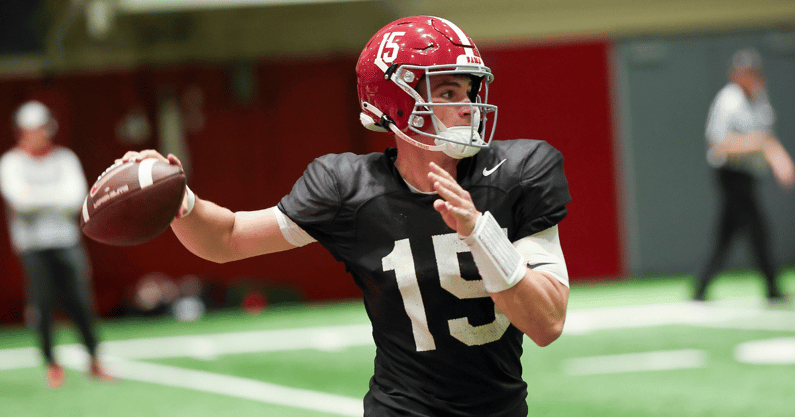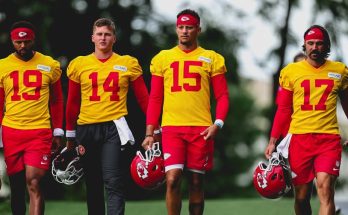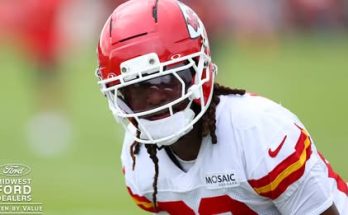In the fast-paced, high-pressure world of college football, where success is measured by the blink of an eye, it takes a special connection for two players to form a bond that can elevate their team. Isaiah Horton, a rookie wide receiver, found that connection almost immediately with his quarterback, who just happens to be the face of Alabama football—the very embodiment of championship-level expectations. Horton’s praise of the quarterback, calling him “a stud,” says it all. In this world of elite athletes, where egos often clash, these words come from a place of respect, admiration, and trust. But how did this bond come to be, and what does it mean for the future of both players, Alabama football, and the broader world of college sports?
A Shared Drive for Greatness
Isaiah Horton’s entrance into Alabama football was not one of mere happenstance. A highly touted recruit from the state of Georgia, Horton had always been a standout on the field. But even with his star potential, it wasn’t until he joined the Crimson Tide’s roster that he began to understand the full weight of what it meant to be part of one of the most successful programs in college football history.
When he arrived, Horton quickly realized that the quarterback position at Alabama wasn’t just another job. It was a leadership role, a responsibility, and, above all, a position that required a high degree of trust and camaraderie with every player on the offensive side of the ball. And in Alabama’s high-octane offense, trust between the quarterback and his wide receivers is paramount. Without that synergy, there’s no chance for success—especially with the eyes of the college football world constantly trained on them.
Horton’s early connection with his quarterback—often referred to as “the stud” by his teammates—was immediate. Both players shared a relentless work ethic and an understanding that success would not come easily. From their first practice together, Horton knew that this was no ordinary quarterback. Alabama’s signal-caller was calm under pressure, decisive in his throws, and had an uncanny ability to lead his receivers to where the ball needed to be, often in the most difficult situations.
Isaiah’s description of his quarterback as “a stud” is not just a reflection of his physical talent, but also of his mental acumen. The way he reads defenses, adjusts plays on the fly, and makes lightning-fast decisions under pressure is what makes him special in the eyes of Horton and countless others around the program. Horton, in particular, was able to bond with the quarterback in ways that were quickly noticeable to the coaching staff and fellow teammates.
The Learning Curve: Building Chemistry
Building chemistry between a quarterback and a wide receiver isn’t just about talent. It’s about hours of practice, endless repetitions, and understanding each other’s tendencies. Horton had seen his fair share of practices, but this was different. The speed of the game at Alabama was something that had to be learned, and learning it meant getting on the same wavelength as the quarterback.
That connection wasn’t built overnight. It took time—practices after practice, workouts, and film study. Both players would arrive early and leave late, working on their timing, learning how to communicate without saying a word, and growing accustomed to one another’s tendencies. Horton would learn to anticipate the ball’s trajectory before the quarterback even let it go, while the quarterback would grow to trust Horton’s ability to make plays when it mattered most.
One of the most important lessons Horton learned from his quarterback early on was the importance of leadership. The quarterback didn’t just throw the ball and hope for the best; he led by example. His work ethic was unmatched. Whether it was throwing extra passes after practice, getting in the weight room, or studying the opposing team’s defense with a keen eye, the quarterback’s drive was contagious. Horton found himself motivated to push past his own limits because of it. Their bond was not just one built on football, but on a shared mentality—one that demanded excellence, one that was unapologetically ambitious.
While Horton’s rookie status meant he had a lot to learn, the quarterback’s leadership helped guide him through the process. They spent hours on the practice field, running routes, studying each other’s movements, and making small adjustments that would make a world of difference come game time. Horton quickly learned that it wasn’t enough to simply run a route; he needed to run it with precision and purpose, knowing exactly how and where the quarterback would deliver the ball.
Building the Offense: The Role of a Rookie Wide Receiver
For a rookie wide receiver, joining an offense like Alabama’s is a daunting task. The expectations are high, and the competition is fierce. But Horton came in with the understanding that he wasn’t just another player—he was part of something bigger. In an offense that prides itself on speed, efficiency, and big plays, Horton knew that his ability to make an immediate impact would depend on his ability to bond with the quarterback.
The system Alabama runs requires receivers to be in sync with the quarterback’s decision-making process. It requires precision, communication, and timing. Horton’s ability to adapt to these demands quickly was a testament to his talent, but it was his bond with the quarterback that truly made him stand out. They were able to read each other’s body language, predict where the ball would be placed, and understand the nuances of the offense. This type of connection can take years to develop, but for Horton, it happened much faster than expected.
Alabama’s offense was designed to take advantage of every opportunity. The quarterback’s ability to scan the field and make quick decisions was crucial, but it was equally important for the wide receivers to be in the right place at the right time. Horton and his quarterback became masters at this dance, finding ways to execute flawlessly even in high-pressure situations.
But it wasn’t just about the Xs and Os. Horton learned the value of perseverance from his quarterback. College football is a brutal game, and there are times when things don’t go according to plan. The quarterback’s ability to stay calm in the face of adversity and keep pushing forward was something that Horton took to heart. In turn, Horton began to take those lessons and apply them to his own game, growing into a more confident and poised player.
The Impact on Alabama Football
As Horton’s connection with his quarterback grew stronger, so did the Alabama offense. The team began to see immediate benefits from their chemistry. Horton quickly became one of the quarterback’s go-to targets, earning his place in the rotation and making significant contributions in key games.
The bond between Horton and the quarterback also had a ripple effect on the rest of the team. When one player is performing at a high level and leading by example, it has a tendency to inspire others. As Horton grew into his role, his confidence and leadership started to influence the rest of the receivers and the offense as a whole. Everyone raised their game, feeding off the energy created by Horton and his quarterback’s partnership.
For Alabama football, this bond between the rookie wide receiver and the quarterback was more than just a tactical advantage. It was a sign of what could be a long and successful partnership that would carry the program into the future. Horton’s early impact, combined with the quarterback’s leadership and vision, made Alabama’s offense one of the most dangerous in the nation.
Looking Ahead
As Horton continues to grow into his role, the relationship with his quarterback will only deepen. Both players have shown that they are capable of great things, and together, they could form one of the most dynamic duos in college football. If their chemistry continues to build, Alabama football could be looking at a future that includes not only more championships but also a new generation of stars that carry the torch forward.
For now, Horton’s assessment of his quarterback as “a stud” is spot-on. He’s not just a great player—he’s a leader, a mentor, and a catalyst for the success of the entire team. And with a rookie wide receiver like Horton alongside him, the sky is the limit. The bond between them is one that will be remembered for years to come, and it serves as a testament to the power of teamwork, dedication, and trust in the world of college football.



